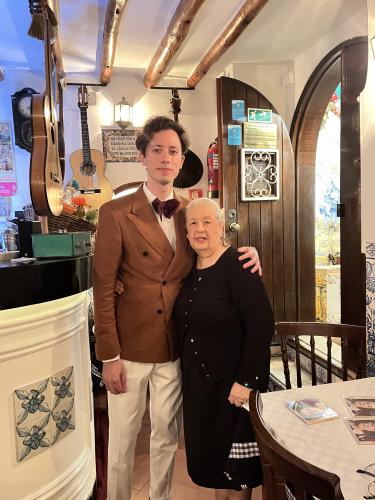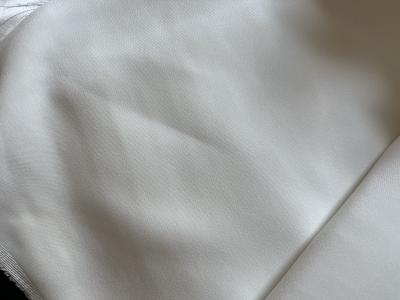Tailoring an Ivory Dinner Jacket by ~mmagueta
The idea of a dinner jacket

Last spring I started to venture the idea of seriously owning a dinner suit. Up until then, I had little motivation to own one, but when I visited Parreirinha de Alfama in Lisbon, I tried to step up the formality with the only decent suit I had on the trip. From that suit I picked my brown linen-cotton blend jacket, a silk burgundy bow tie and a pair of odd white trousers.
Although I certainly was well received by the owner and staff (the owner gave me the table with the best view, for which I am forever grateful), I have my doubts that was an appropriate choice. What I judged to be an adequate pick back then, was no more than a sloppy experiment that foreshadowed my taste for fine dressing. Since then, I bought a vintage dinner suit in barathea with grosgrain silk lapels in a double breasted peaked layout. The main problem is, that is most definitely not a fabric that you can wear in Brazil, most of the year at least, without overheating.

The thing is, dressing to the occasion is a must. It is a form of resistance to the trend of trivializing respect to the point of enforcement. Menswear encompasses much more than just clothing, it is about making the environment around you cordial to the point of inculcating ideals aligned with the Logos. That goes to the point of intoxicating people to lift their hopes for a more ideal world conquered through beauty and purpose. It becomes self evident when others change their behavior because of your suit, because of your cordial “good morning” or because of your inspiring ideal that is being revealed with gentleness. Being a gentleman and following etiquette is about ordering the world.
With that, it became clear that once again I had to bend classical rules of menswear to the Land of the Holy Cross. The mission to bring a piece of the beauty I tried abroad back home is now a must! It is part of my life mission to turn the world of the people around me more beautiful, aspiring to something eternal in that. And I happen to like one of such ways: being a gentleman. It is quite sad to see the idea of a gentleman being associated with snobbery and lavish purposeless enterprises. The point of etiquette, for example, is to put an order to the world we live in, even in the way we delight in a three-course meal or speak to our grandparents! It is not to add ridiculous arbitrary class separations to make people find a faux escape from their gnostic fever dreams.
Much like the Ionic school pioneering a cosmological theory, I entertained bringing that cosmology to the concrete world. For that grandiose plan, I certainly needed guidelines and adaptations. Which to much of my luck, such guidelines had already been covered a few times by the Gentleman’s Gazette, for example. There is no excuse for not embracing an ivory dinner jacket now.
That all would be great in the resounding voice, if not for one little problem: I needed a quality fabric.

The fabric of choice
Choosing a fabric is already not an easy task, but if your supply is limited, things go even further down that path. While Brazil is a huge farm (and thankfully it is somewhat efficient at that), it is not very industrialized. Pair that with insanely punitive import tariffs and all of a sudden getting good fabric turns out to be impossible.
Most of cotton and wool around are of poor quality or of novelty patterns. My choices were between some synthetics, which are quite strictly akin to wearing a plastic trash bag (the drape is the same of one, at least); and bad quality natural fibers. It was almost impossible to find fresco wool, linen and cotton (believe it or not) in some white tone of good quality that were not imported. Remember, Brazilian tariffs on imports are of 60% on the product + shipping fee, so a mug that was 5 dollars with shipping of 10 dollars is charged with an extra 9 dollars, so the mug was actually 24 dollars – now do the math with a 950 dollars for 2 meters of some Italian fabric, plus 70 dollars of shipping, it’s a whopping final cost of 1632 dollars. Considering that’s just for the fabric, and most of the money serves to fund my government, that is a choice I can hardly defend.
At that point, I considered giving up on the idea, and simply getting the fabric on a trip, or just planning a flight to Europe and having it bespoke in there. It would not have been cheaper, but I would already combo some vacations I suppose, instead of living the dream of Brazilian positivist protectionism.
As a last resort, I talked to my local tailor to see where I could get decent fabrics, and surprisingly, he knew of a guy that knew another guy that cultivated silk-worms in a ranch for exports. And by a strike of luck, one of his suppliers planned on having some of his raw silk milled. They happen to mill it simply for exports, since there is an insignificant demand for input materials on the domestic market. The tailor arranged a conversation with the supplier and I felt it was a safe bet, if it were actually silk. Not all silk is the same, that’s absolutely true, but for a decent price and for the certainty of a fairly decent piece of a cloth, it seemed like a good deal.

So then it turned out that the best choice overall was to go to their warehouse and hopefully the seller would cut the 2 meters I needed. It is interesting that the fabric I least expected to find at that price point was silk. The weave was soft to the touch, it had a beautiful heavy crêpe finish (good for the drape I was going for) and it was subtly lustrous over the light, unlike polyester that does not absorb the light very well. After a proof test and the certification seal, I could then say that was the real deal. Ivory silk, the cloth I never considered to be a perfect match for my needs, was there at my reach.
Silk is perfect because it is insulating. Cotton might wear cooler at a fairly open weave, with silk in comparison wearing hotter indeed, it is moderately breathable too however. In most cases this would not be ideal for a scorching summer, but it is a good compromise to an all-year-round sub-tropical weather stage. That meant I could attend black tie events in Rio and São Paulo or even in Montevideo and Buenos Aires with quite a leeway.
The design choice
With the fabric in hand and my piggy bank untouched, I could finally dream of the design.
While I considered going with lapels in another shade of white, going for a champagne or winter white, I judged that to be an overstatement I could not afford to go with shawl collar lapels. It is an unique lapel shape that, if done wide, can be truly charming and a privilege of evening wear.
Pini Parma offers satin shawl lapels that perhaps I should pass down to my tailor, which is a good compromise with the previously considered champagne.

The absence of lining would be a must to compensate for the insulation caused by the fabric and a full canvas; but to maintain the tropical aesthetics, Spalla Napoletana was the choice for the shoulders, which also helps to harmonize with the lapel roundness.
Since in a proper dinner jacket there should be no vents and it should hold one’s silhouette, enlongating it a tiny bit is not such a bad idea, so keeping a 6x2 double breasted configuration with a high buttoning point would probably make things look disproportional. For that reason I chose to go with a 4x1 buttonning, making the lapels go even lower, accepting the exposure of a 3 shirt studs instead of two.
To finish, I opted for covering the buttons in satin, which I think accentuates the design even further.
Some other choices not so important were double inner pockets and turned cuffs.
What I learned
Distorted economy
In a distorted economy, choices are certainly not made rationally upfront. There is a fog of information that is distorted from the ideal, so investments such as these make little sense. At some point, the cost per wear of an import would be kafkian insanity, and it would simply not worth, even for someone that enjoys dressing classically often like me.
Contacts
In this case, the fabric was far from being the best of the best, but still it was a good find overall, which was simply not markeatable. I could only discover it because I went out of my indignation and consulted other people, helping to correlate the information. Perhaps this applies to open source too! Many times were those that I heard of problems in software because of conversations such as these. Staying quiet and not engaging into a community is begging to pay for a higher price. Information decreases costs.
Generalities VS Specifics
The average (good) menswear guide will be just that, a guide. It contains guidelines you must follow (or at least break them with awareness) and the prospect of advice from more experienced people is always very welcome. But for these authors, it is simply economically inviable to account for every minimal detail that applies to the context of people. Should I really expect someone writing a guide on how to make a tropical-compliant evening garment in a positivist protectionist country? It is only by the power of abstractions that we can conquer such barriers. The specifics need all to be considered to find compromises with the ideal, all these accidental cases ought to be evaluated coumpounding their priority so the optimal decision may follow.
Disclosure
I will soon the posting pictures of the final piece when it’s done!